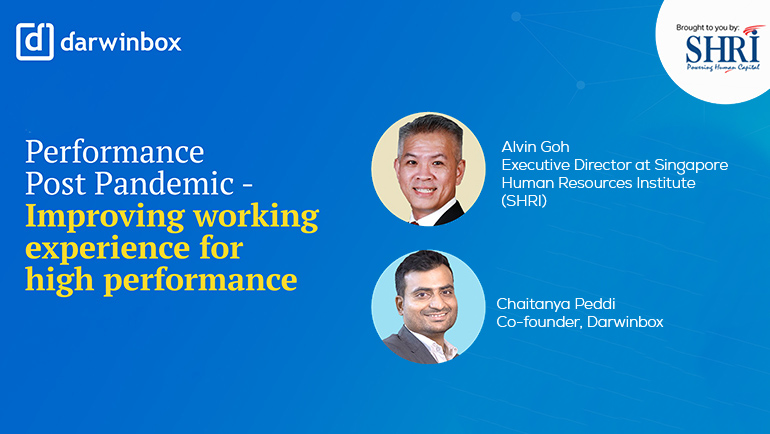

The COVID pandemic has altered the existing realities for workplaces. Organisations are evolving with the new normal and adapting to the new possibilities. And one of the top priorities for business leaders is to drive high productivity in the new normal
SHRI, Singapore’s leading professional HR body in association with Darwinbox hosted a session on improving the working experience for high-performance post COVID-19.
The session invited Alvin Goh, Executive Director of SHRI and Chaitanya Peddi, Co-Founder of Darwinbox to share their expertise on the subject.
Here are the highlights of the session:
Evolving Realities
With work going remote, teams are now more distributed and hence collaboration has been one of the biggest challenges. Especially for new hires, not having met the teams and their leaders also leads to a fair bit of disengagement and disconnect. Moreover, with no clear ON and OFF button for work, and an uncertain future, it has taken a toll on people’s mental and physical wellbeing as well.
In such times, there is a clear need to reimagine the role of HR. There is a need to build more agile systems and continuously fine-tune them to handle the new world of work. Not to forget, HRs will have to keep an eye on employee emotions and state of mind to drive productivity.
These are some of the ways in which businesses can drive engagement:
Continuous conversations with timely nudges:
Most businesses are adopting more continuous ways of measuring performance by using advanced HR Tech features. With the Darwinbox system, managers and employees can use the chat feature to give and receive feedback and schedule one on one conversations to discuss matters of Importance. The process is so open ended that employees can even rate their one-to-one conversations with their respective managers on how they felt the conversation went.
OKR Framework for goal planning and management:
Many organisations are increasingly opting for this new model of performance management that is a fairly simple system of measuring Objectives with their corresponding Key Results. The Key Results can be aligned from the organisation to the department and then to the individual and thus helping drive both alignment and engagement.
Real-time integrations with other systems:
To reduce manual labour and increase efficiency, Darwinbox system offers real-time and seamless integrations with other project management tools. For example Jira for engineering professionals, or Salesforce for marketing folks or manufacturing systems for traditional sectors etc.
Continuous feedback:
The focus of performance management post pandemic is largely on employee engagement. In that regard, continuous feedback promotes cross-functional collaboration which proves to be more effective in keeping the employees involved in their own performance progress and understand their critical areas to improve upon.
Unified dashboard for single view:
Talent management is not solely an HR function. While they can be process owners, the accountability lies with people on the floor i.e employee and manager. That means that data has to be visible to all the stakeholders and not just limited to certain layers in the organisation. For example, a manager should be able to view the performance data of all her direct and indirect reportees across the organisation on a single dashboard. She can get a view of the talent distribution, who are the top performers, how are the goals progressing for everyone, competency gaps and more.
Continuing the thread of conversation, Alvin Goh, discussed the 5 key areas to look into as businesses move into the new normal.
- Platform - Any platform that businesses choose should act as an enabler to make work more effective and efficient. Businesses should look at replacing the good with the better in order to realise their strategies.
- Processes - Organisations need to rethink their processes and can use methods like Value Stream Map to ensure work processes are streamlined and reduce wastage.
- Procedures - While procedures can strengthen a system, they should not act as an impediment to efficiency by adding unnecessary layers to workflows.
- People - From personnel management, to human resource management, to human capital management, businesses have to rethink how they operate now and not get too caught up in buzzwords like VUCA, reskilling and upskilling etc. It is not just about these terms. Ultimately, organisations must be able to help their employees cope with the new scenario and train them to excel even in the face of adversities.
- Transformation - While digital transformation is crucial, and even more so in the new world of work, organisations will have to think what best suits their context and their business context.
Another critical piece of the puzzle in ensuring higher employee engagement post pandemic is how the business leaders are conducting themselves. Now, more than ever, people have realised that compassion and empathy are two very important skills for a leader. Can leaders truly be compassionate in this tough economic environment? The webinar answered this question by focusing on some interesting ways in which leaders can be encouraged to foster compassion in their organisation.
Watch the full session here to learn more about what experts have to say about building high-engagement and high-productivity workplaces once the COVID crisis is over.



Speak Your Mind